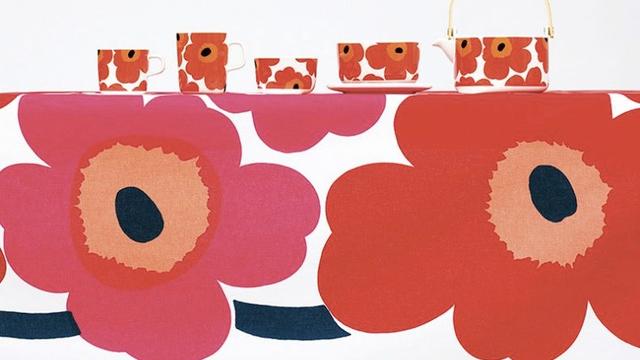In the years after World War II, most of Europe was devastated, both physically and financially. From this drab reality, one country began producing bright, technicolour textiles, including a print which bolstered its economy, created national pride, and ended up becoming one of the most beloved and recognisable patterns in the world.
The postwar outlook was especially dim for the tiny nation of Finland. The country had actually fought three wars: one to keep invading Germans at bay and two against the Soviet Union, which resulted in ceding some of their land, including two of their ports, to the USSR. In the spirit of rebuilding the country economically, residents wanted to buy local — not an easy task as the manufacturing boom had not yet reached the Scandinavian country and most people still made their livings from farming.
As a Finland-based company that brought industrialisation to the nation with a bold, future-forward mission, a tiny fabric company named Marimekko launched at the exact right time. Marimekko actually began its life as Printex, a textile and oilcloth company bought by Armi Ratia and her husband Viljo. Ratia noticed that most of the fabric orders at the time were destined for draperies and tablecloths, so she thought that she could expand the line with vibrant, au courant prints which could also be used to make clothing.

The first Marimekko fashion show, in 1951
Ratia began recruiting Finnish artists and textile designers, such as Maija Isola and Vuokko Nurmesniemi, to create patterns that became known for their abstract shapes and bright colours.
A fashion show held in May of 1951 at a Helsinki restaurant hosted the debut of her line Marimekko, which translated to “Mary’s dress” in Finnish. The dresses were a hit, and the first Marimekko retail store opened the following year. Ratia reportedly typed the word on an Olivetti typewriter to create the logo.
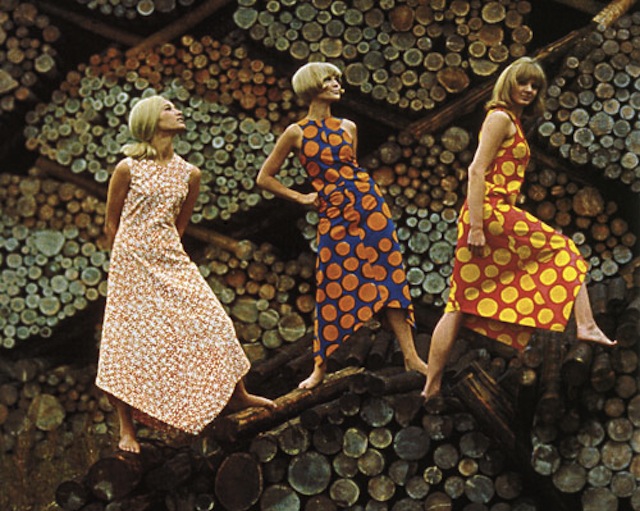
A photoshoot for the cover of Life, 1965
The fabric was sold at stores by the yard (on bolts branded with the designer’s name, year, and “Finland”), but Ratia also continued to tap designers to create clothing lines. This evolved into a stark departure from the more structured dresses of the 1950s. The pieces were free-form and comfortable, in a way that ushered in the spirited, easygoing fashions of the ’60s.
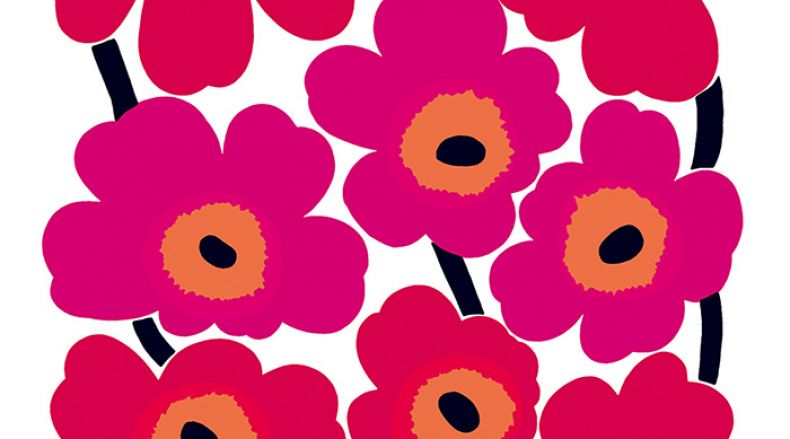
The original Unikko colorway, designed in 1964
This new look became an almost anti-depressive prescription to help the country emerge from under the rubble of war: Marimekko was pure day-brightening, mood-altering happiness. But none of the patterns would become as popular as Unikko (“poppy”), which debuted in 1964.
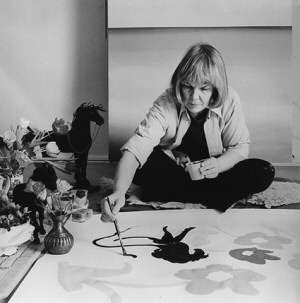
By that time Isola had joined the company as chief textile designer. The story is that Isola created the design out of protest after Ratia declared that Marimekko would never have a floral print.
It would end up becoming a signature pattern for the company, ubiquitous throughout Finland, and one of the most well-known patterns in the world.
Travelling the world for inspiration, Isola often found her muses in the fields and forests of the natural world. Many of her prints were created by projecting leaves and branches on to a screen and photographing the shapes, adding additional hand-painted elements on giant reams of paper at actual size.
Isola went on to design 500 prints for Marimekko, many of which have been re-released in recent years. Unikko was first available in red, pink and black, but quickly expanded to a variety of other colorways, and can be found made into everything from sheets to shower curtains.
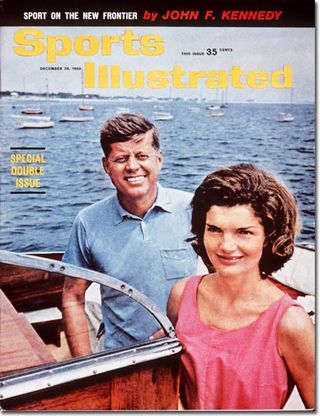
Marimekko quickly become a calling card for Finnish fashion all over the world. In 1957, Giorgio Armani invited Ratia to sell her clothes at an Italian department store, exposing Marimekko to an international audience. The brand was brought to the U.S. by architect Ben Thompson, who sold clothing and housewares at his popular Design Research (D/R) stores.
In December of 1960, Jacqueline Kennedy was featured on the cover of Sports Illustrated, which hit the stands just after her husband’s successful re-election campaign. She wore a red sleeveless Marimekko dress she purchased at D/R, and had reportedly bought six more.
That was really all the company really needed to become a runaway success in the U.S. Retail stores opened here and in several other cities around the world.
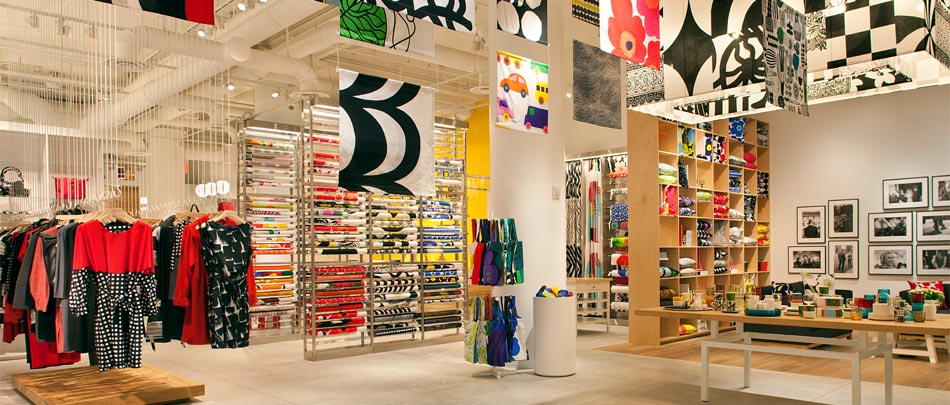
A Marimekko retail store today
Even with the worldwide momentum, as Marimekko’s dresses and fabrics were featured on the covers of magazines like Life, Elle and Vogue, the company was plagued by internal struggles and high production costs.
Then Ratia died in 1979, just as Marimekko was about to face its greatest challenge. In the 1980s, as the Cold War ended, Finland suffered a financial crisis that lasted into the 1990s. As one of the only non-Eastern Bloc countries to share a border with the USSR, they had benefitted from a special trade agreement with the country. As the USSR collapsed, and the country now known as Russia began importing from other countries, Finland’s economy faltered.
Marimekko was bought by a large conglomerate which couldn’t turn around its troubles. Ratia’s heirs tried to rally, but Marimekko was brought to the brink of bankruptcy. Until it was, by many accounts, rescued by ad exec Kirsti Paakkanen, who took over operations in 1991.
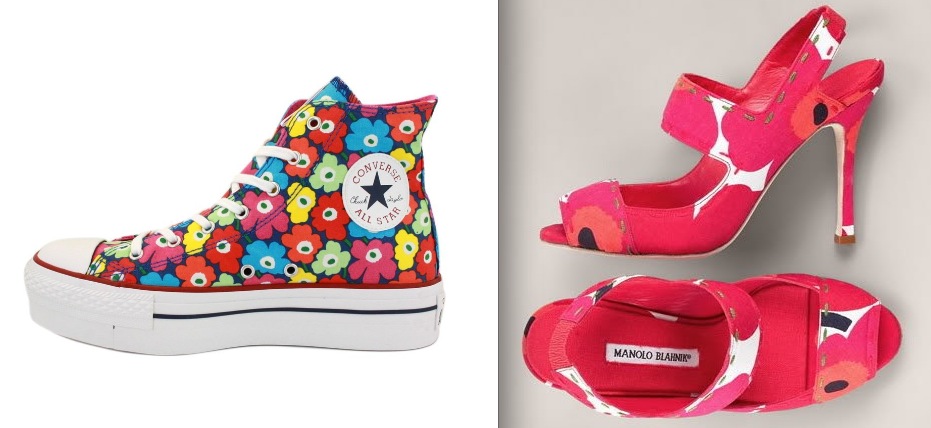
Partnerships include Unikko licensing deals with Converse and Manolo Blahnik
By bringing in younger designers and repositioning the company, Marimekko now has partnerships with Crate & Barrel, H&M, Converse, and Manolo Blahnik that help to deliver the prints to the next generation. Clothing and fabrics were featured on Sex and the City. (I suppose Carrie Bradshaw, in her own way, was like the Jackie-O of her day.)
Paakkanen slowly handed over a revitalized company to banker Mika Ihamuotila in 2008.
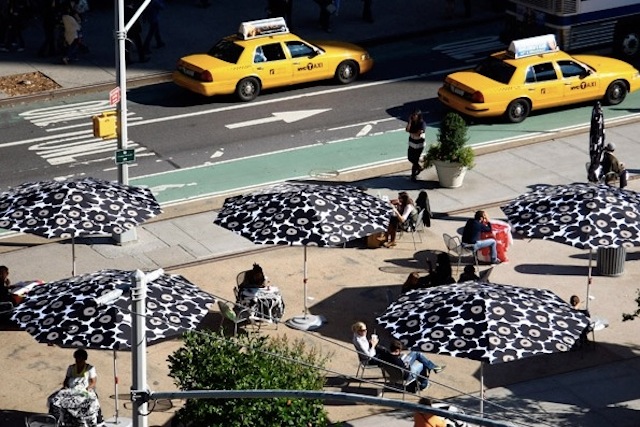
Unikko umbrellas outside the New York City flagship in 2011
In 2010 Marimekko opened a flagship store in New York City, and today counts over 125 stores and licensed retailers. In 2012 the brand debuted its collections at Tokyo Fashion Week for the first time. A social network called Marimekko Village was launched, which appears to appeal directly to the Pinterest crowd. The company is currently in the midst of reorganising again and looking for a new international creative director.
Marimekko was able to bring Finland’s talents in front of a national audience, gaining global recognition for the tiny Nordic population. But it also created a real sense of pride within the country itself: Marimekko helped to cement Finland’s status as a design-savvy culture, along with other companies like Artek and Iittala. The brand continues to nurture and promote Finnish artists across a wide range of products, serving as a goodwill ambassador of sorts, with a mission that Ratia once called “a cultural phenomenon guiding the quality of living.”
In honour of Unikko’s 50th birthday, Marimekko is rolling out a new series of products including some new colour combinations. A half century later, it looks as fresh and contemporary as it did emerging from Isola’s paintbrush.
Although not everyone knows the history behind the pattern they might have first encountered on an aunt’s handbag or a girlfriend’s pillowcase, Unikko endures as one of the best-known patterns on earth. And for those who learn its origins, the connection becomes unforgettable.
Marimekko put Finland on the map, with an indelible bright red blossom.
All images courtesy Marimekko, except Isola: Scandinavian Design Museum; Sports Illustrated: Helsinki.ru; Life magazine spread: Cathy of California/Marimekko
